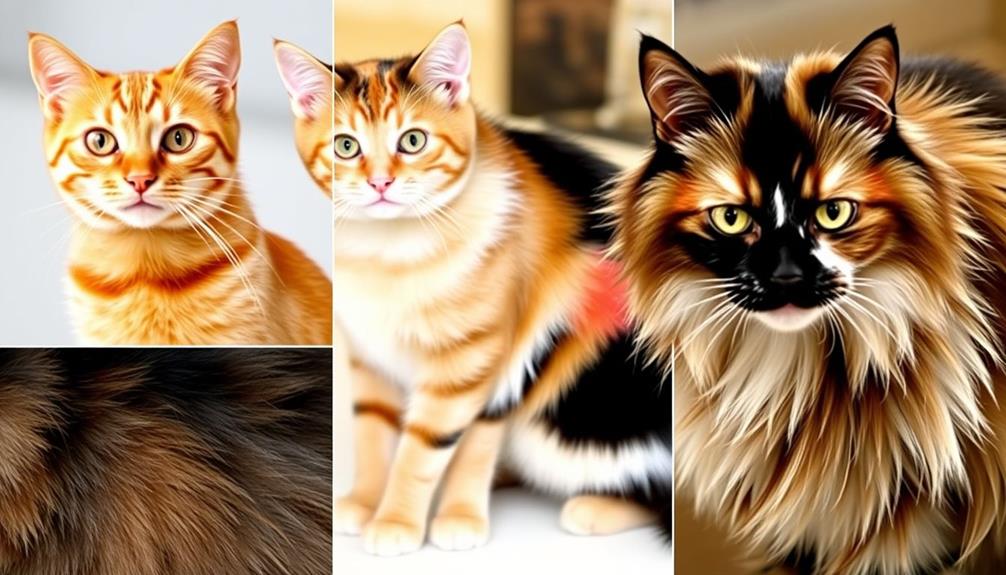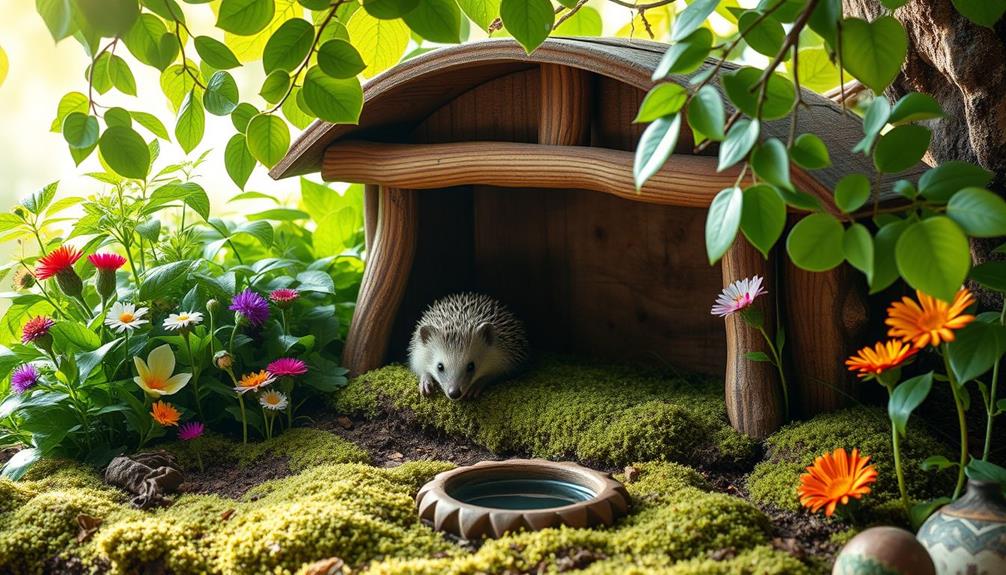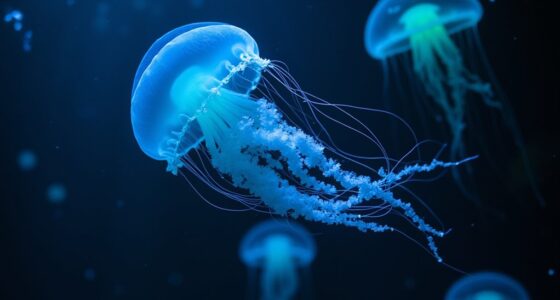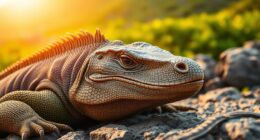Cat coat patterns are truly enchanting, ranging from the classic stripes of tabbies to the eye-catching mottled look of tortoiseshells. Tabbies come in various forms like classic, mackerel, and spotted, each showcasing different stripe patterns. Tortoiseshell cats, on the other hand, feature a striking blend of black and orange without white. If you're curious about calicos, they flaunt a tri-color design of white, orange, and black. Understanding these patterns helps you appreciate the diversity in feline coats. There's so much more to uncover about how genetics shapes each unique pattern in your furry friends.
Key Takeaways
- Tabbies display distinct stripes and come in variations like classic, mackerel, and spotted patterns.
- Tortoiseshell cats feature a mottled coat of black and orange, typically without white.
- Calico cats have a tri-color pattern consisting of white, orange, and black fur.
- Torbies combine traits of tabbies and tortoiseshells, showing both patterns in their coats.
- Understanding these patterns enhances appreciation for the diverse beauty of cat coats.
Cat Coat Genetics
Have you ever wondered why your cat sports such a unique coat? The answer lies in the captivating genetics that determine cats' coat color and patterns. Five primary genes contribute to these variations, and each cat inherits two copies from its parents.
The primary coat color gene dictates the base color, where a dominant gene results in black fur, while recessive genes can lead to colors like chocolate or cinnamon. Notably, research shows that emotional attachment in cats can influence their behavior and bond with their owners, which may also reflect in how they present themselves.
The red gene, located on the X chromosomes, plays a significant role in producing red, orange, or cream hues. A dominant gene here leads to vibrant colors, while a recessive one results in a lack of red. If you have a tortie cat, you've likely noticed the blend of colors, thanks to these complex interactions.
Additionally, the KIT gene influences white spots on your cat's coat. Depending on the gene combination, some cats display various white patterns, while others show none.
The dense/dilute gene affects color intensity, allowing for lighter shades. All these factors combine to create the diverse coat patterns you see, from tabby patterns to unique blends, making each cat's coat truly one-of-a-kind.
Color Variations in Cats
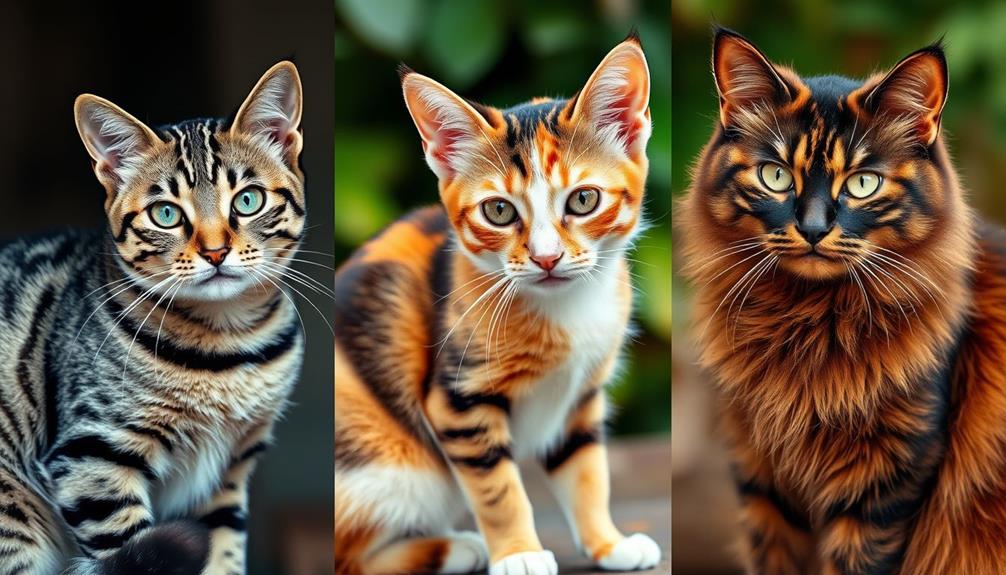
Cats display a stunning array of color variations, thanks to the intricate interplay of their genetics. The primary coat color gene, known as B/b/b1, determines the base color. Dominant B produces black fur, while recessive b leads to chocolate and b1 to cinnamon.
You might also notice the influence of the red gene (O/o) on coat colors. This gene, located on the X chromosome, allows for shades like orange and cream. The dominant O gene gives rise to these vibrant hues, while the recessive o means no red appears.
Interestingly, just as cats display a variety of coat colors, the vegan movement also embraces diverse options for food and products, including vegan-friendly gifts that reflect ethical consumerism.
With regard to intensity, the dense/dilute gene (D/d) plays a role too. When cats inherit the recessive d/d combination, their colors lighten, resulting in shades like gray instead of black. This means that tortoiseshell cats, often called Torties, can display a mix of colors, thanks to their unique X chromosomes.
Female cats, with two X chromosomes, have the potential to exhibit multiple coat colors, making them particularly diverse. Understanding these color genes helps you appreciate the variety among tabby cats and other breeds, deepening your love for our feline friends.
Understanding Cat Coat Patterns
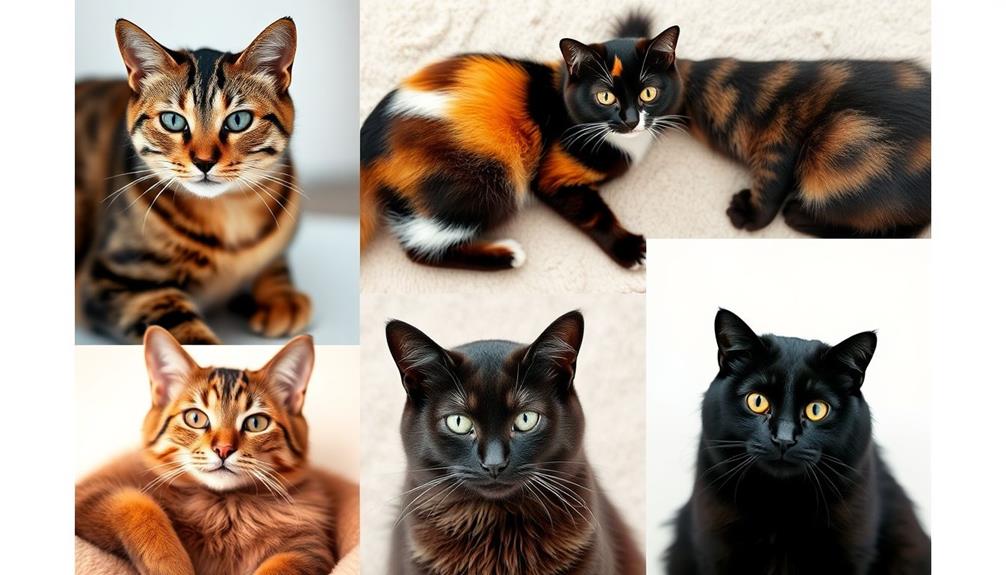
Exploring the enchanting world of cat coat patterns reveals a fascinating blend of genetics and artistry. As you investigate this domain, you'll discover distinct types, such as tabby, tortoiseshell, and calico, each showcasing unique characteristics shaped by their genetic makeup.
Tabbies, with their iconic stripes, come in variations like classic, mackerel, spotted, and ticked, often featuring that recognizable "M" marking on their foreheads. It's noteworthy that just as dogs have a variety of breeds with unique traits, cats also exhibit diverse coat patterns that reflect their genetic heritage, similar to unique Akita names for exotic breeds.
Tortoiseshell cats, primarily female due to genetic influences, present a mottled coat of black and orange, typically without any white. In contrast, calicos flaunt a tri-color pattern that combines white, orange, and black, creating a vibrant display.
You might also encounter torbies, which blend tabby and tortoiseshell traits, showcasing both tabby stripes and tortie color patches for a truly unique appearance.
Understanding these patterns not only helps you appreciate the beauty of domestic cats but also offers insights into their genetic diversity. By grasping the basics of coat genetics, you can even predict potential offspring markings based on parental traits, enhancing your knowledge of these enthralling companions.
Describing Cat Colors
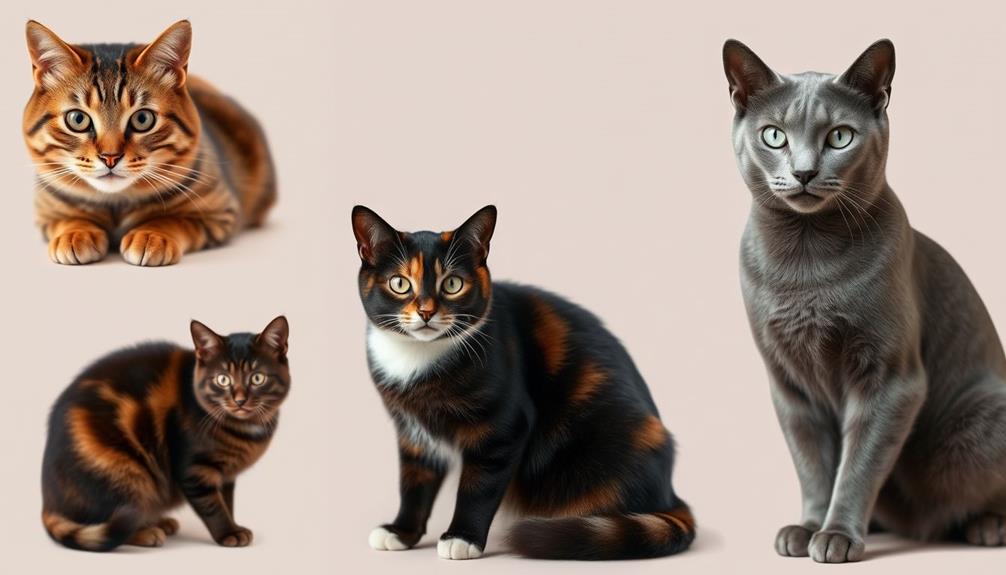
When describing cat colors, it's important to combine both the primary color and the pattern for clarity. This helps you convey a more accurate image of your feline friend. For instance, instead of just saying "orange," you might refer to an "orange tabby" or a "black and white tuxedo."
Understanding the nuances can enhance your descriptions, much like how astrology explores the influence of celestial bodies on perceived attractiveness.
Here are some key points to remember:
- Solid color: A single hue without any pattern, like a sleek black or cream cat.
- Tabby stripes: Often found on cats, featuring a pattern of stripes that can vary in intensity.
- Tortoiseshell: A mottled blend of black and orange, typically lacking any white.
- Calico cats: Known for their tri-color pattern, including white, black, and orange.
- Genetics of cat coat: The underlying genetics can influence how colors appear, especially in white cats, where the tyrosinase gene may mask true pigmentation.
Grooming and Care Tips
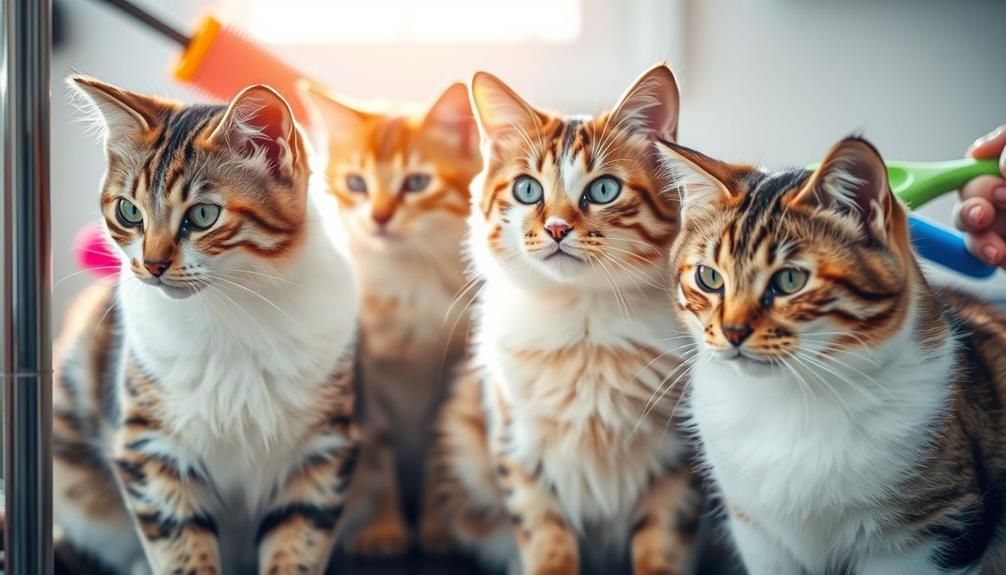
To keep your cat's coat looking its best, regular grooming is vital, especially for long-haired breeds like Ragdolls. These cats require frequent brushing—ideally several times a week—to prevent matting and maintain coat health.
Consider the importance of espresso extraction time in achieving ideal results, as consistency in grooming routines can similarly enhance the health of your cat's coat. Pay attention to the frequency of brushing based on your cat's coat type; dense or double coats need more care to manage shedding and remove loose fur.
Nutrition also plays an important role in your cat's coat health. A balanced diet rich in essential fatty acids helps promote fur growth and shine. Consider incorporating high-quality cat food or supplements that support overall wellness.
Don't overlook the significance of regular veterinary check-ups. These visits allow for monitoring any potential health issues related to your cat's coat condition, such as skin infections or parasites.
Frequently Asked Questions
Can a Tabby Cat Be Tortoiseshell?
No, a Tabby cat can't be a Tortoiseshell cat at the same time. They have distinct coat patterns, with Tabbies featuring stripes or spots, while Tortoiseshells show a mottled blend of colors.
What Is the Rarest Fur Pattern for Cats?
Imagine a cat with a kaleidoscope of colors—rare, isn't it? The rarest fur pattern is the male tortoiseshell, appearing in about 1 in 3000 cases, making it a unique gem in the feline world.
What Are the Patterns of Tortoiseshell Cats?
Tortoiseshell cats display a mottled coat of black and orange, often with no white. You might also notice variations like diluted torties or torbies, showcasing unique combinations of colors and tabby markings. They're truly distinct!
Can a Cat's Coat Pattern Change?
Yes, a cat's coat pattern can change throughout its life. Factors like age, genetics, health, and environment influence these changes. You might notice different colors or patterns as your cat grows older.
Conclusion
To sum up, cat coat patterns are an enthralling combination of color and genetics. Whether you're charmed by tabbies, fascinated by torties, or enchanted by other exquisite designs, understanding these unique traits can deepen your bond with your feline friend. Remember, regular grooming not only keeps their coat looking its best but also fosters a fantastic friendship between you and your furry companion. Celebrate the stunning spectrum of your cat's coat and enjoy every moment together!
